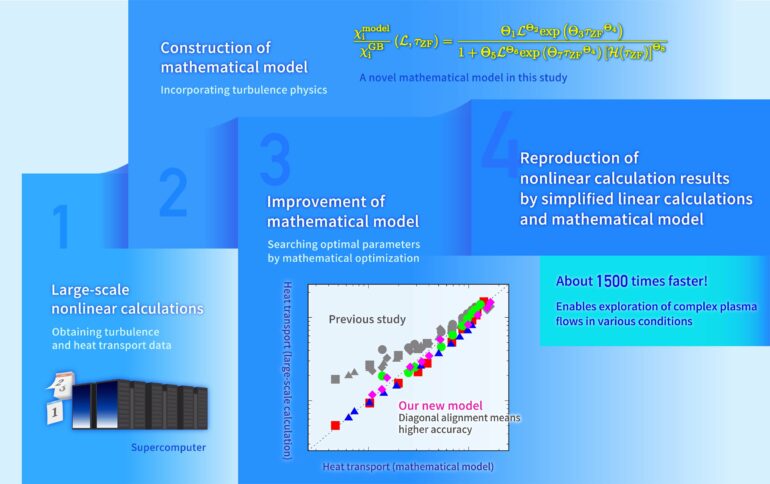Accurate and fast calculation of heat flow (heat transport) due to fluctuations and turbulence in plasmas is an important issue in elucidating the physical mechanisms of fusion reactors and in predicting and controlling their performance.
A research group led by Associate Professor Motoki Nakata of the National Institute for Fusion Science and Tomonari Nakayama, a Ph.D student at the Graduate University for Advanced Studies, has successfully developed a high-precision mathematical model to predict heat transport levels. This was achieved by applying a mathematical optimization method to a lot of turbulence and heat transport data obtained from large-scale numerical calculations using a supercomputer.
This new mathematical model enables the prediction of turbulence and heat transport in fusion plasmas using only simplified small-scale numerical calculations, which are approximately 1,500 times faster than conventional large-scale ones. This research result will not only accelerate research on fusion plasma turbulence, but also contribute to the study of various complex flow phenomena with fluctuations, turbulence and flows.
The paper summarizing this research result was published open access in the online edition of Scientific Reports on March 16.
Research background
In general, large-scale numerical calculations using supercomputers are indispensable to quantifying the physical mechanisms of complex structures and motions, such as atmospheric and ocean currents, neuronal signal transduction in the brain, and the molecular dynamics of proteins.
In a fusion reactor, high-temperature plasmas (high-temperature gaseous material in which electrons and nuclear ions are moving separately) are confined by magnetic fields, and a complex state called turbulence can occur in the plasma. The complex motion of vortices with various sizes cause heat flow (heat transport) in the turbulence. If the confined heat in the plasma is lost due to turbulence, the performance of the fusion reactor will be degraded, thus plasma turbulence is one of the most important issues in fusion research.
Large-scale numerical calculations on supercomputers have been used to investigate the generation mechanism of the plasma turbulence, how to suppress it, and the heat transport due to the turbulence. Nonlinear calculations are used to solve the equations of motion of the plasma. However, since turbulence varies depending on the plasma state, enormous computational resources are required to carry out large-scale nonlinear calculations for the entire plasma region with a variety of states. There has been much research attempting to reproduce the results of nonlinear calculations by simplified theoretical models or small-scale numerical calculations, but the degraded accuracy for different plasma conditions and the limited range of applications left room for improvement. Therefore, a new mathematical model that can solve these issues was needed.
Research results
A research group led by Associate Professor Motoki Nakata of the National Institute for Fusion Science and Tomonari Nakayama, a Ph.D student of the Graduate University for Advanced Studies, Professor Mitsuru Honda of Kyoto University, Dr. Emi Narita of the National Institute for Quantum Science and Technology, Associate Professor Masanori Nunami and Assistant Professor Seikichi Matsuoka of the National Institute for Fusion Science have conducted their study on a novel method to reproduce the nonlinear calculation results of turbulence and heat transport by “linear” calculations, which are small-scale ones based on a simplified equation of motion. Thus, a high-speed and high-accuracy prediction with wider applicability has been achieved.
First, Prof. Nakata and his colleagues performed a number of large-scale nonlinear calculations to analyze turbulence at multiple locations in the plasma and at many temperature distribution states, and obtained the data on the turbulence intensity and heat transport level. They then proposed a simplified mathematical model based on physical considerations to reproduce it. This contained eight tuning parameters, and it was necessary to find their optimal values to best reproduce the data from the large-scale nonlinear calculations. Mr. Nakayama, a graduate student, searched for the optimal values among a huge number of combinations by applying mathematical optimization techniques used in path finding and machine learning. As a result, he succeeded in constructing a new mathematical model that maintains high accuracy and greatly expands the range of applicability compared to that used in previous research.
By combining this mathematical model with linear calculations for plasma instabilities, it is now possible to predict plasma turbulence and heat transport level with high accuracy—about 1,500 times faster than conventional large-scale nonlinear calculations.
Significance of the results and future developments
The newly constructed fast and accurate mathematical model will greatly accelerate research on turbulence in fusion plasmas. In addition, the model will also advance research on integrated simulations, combining the mathematical model of turbulence and numerical simulations of the other phenomena (e.g., temporal variations in temperature and density distribution, confinement magnetic field, etc.) in order to analyze the entire fusion plasma field. In addition, the model is expected to contribute to the understanding of the mechanism of suppressing turbulence-driven heat transport, and to make a significant contribution to research towards innovative fusion reactors based on such a mechanism.
The challenge of predicting “complexity” from “simplicity” is a common issue in various sciences and technologies that deal with complex structures and dynamics. In the future, we will apply the modeling methods developed in this research to the study of complex flows, not limited to fusion plasmas.
More information:
Tomonari Nakayama et al, A simplified model to estimate nonlinear turbulent transport by linear dynamics in plasma turbulence, Scientific Reports (2023). DOI: 10.1038/s41598-023-29168-w. www.nature.com/articles/s41598-023-29168-w
Provided by
National Institutes of Natural Sciences
Citation:
Simplified calculations reproduce complex plasma flows (2023, March 24)
